Roman Art quiz 5
1/27
There's no tags or description
Looks like no tags are added yet.
Name | Mastery | Learn | Test | Matching | Spaced |
|---|
No study sessions yet.
28 Terms
Rome: Tomb of Eurysaces (late 1 c BC)
-“This is the monument of Marcus Vergilius Eurysaces the baker, a contractor…”
-may have a state contract to bake bread for army, which is why he has money for land and tomb
-the funeral space is a great way to see identity statements from non-state actors
-unusually well preserved
-idiosyncratic (peculiar) form
-some believe tubes are vessels for the baker
-some believe the images point to Eurysaces as an elite among the workers, similar to the real elites
L’Arringatore (ca 80 BC)
-position indicates he is speaking in the forum square
Tomb of the Haterii (late 1st C AD)
Rome- Via Labicana
-left: a scene of mourning
-right: ancestors
-private industry
-state-adjacent themes to portray identity
Sarcophagus with scene of the Niobids (Ca AD 160-170) via Appia
-Niobids: children that apollo kills
- greek mythology: more sophisticated
The Labors of Hercules ca 170 AD
- greek mythology: more sophisticated
Portonaccio Battle Sarcophagus (ca 180-190 AD) - Portonaccio
-direct geographical impulse
-seems unfinished
-very complex work
-layered composition
-main person’s face seems unfinished
-was this made with someone specific in mind or just if someone comes in
-Hawara - Mummy with an Inserted panel portrait of a youth (ca. AD 80-100)
-are they made during the lifetime and reused or are the made at the time of death
Panel Painting of a woman in a blue mantle Neronian, AD 54-68
The Jewelry Girl
-private, not of state interest
-for upper middle class and above’
what?
Portus - Isola Sacra necropolis
-working class
-mostly cremation tombs
Portus - Isola Sacra - tomb 29 (late 2nd C AD)
-Plaques ar mounted on tombs
-they are focused on trades
Funerary relief of decorators at work (2nd c AD sens museum)
-the material turn: being interested in not just the end project but the steps to get there
-roman wall art is challenging
-bottom person is preparing the layer you apply first (plaster)
-top right is applying to wall in multiple layers (top layer is smoothest)
-top left is applying paint to wet plaster (fresco technique [fresh])
-fresco pieces last very long
-most pigments are naturally sourced making them more expensive so more expensive colors are indicators of status
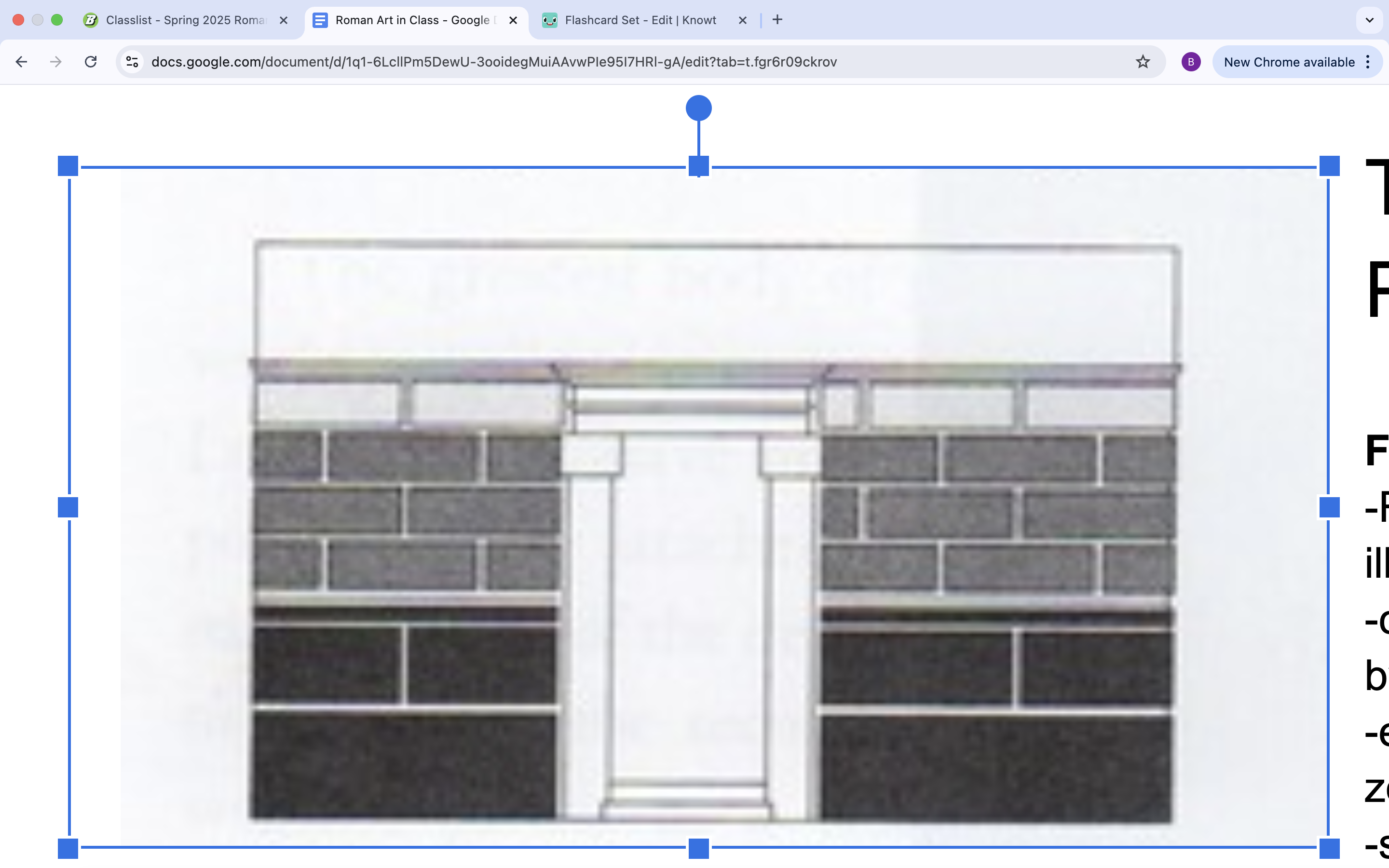
(200-60 BC) masonry, encrustation
FRIST: has no figural scenes
-Roman wall painting is about illusion and imitation
-comes into the italian peninsula by the greek island of Delos
-envisioned as a sequence of zones
-second from the bottom (orthostates) is most important: larger panels
-use plaster and paint to imitate masonry
-part of a decorative environment
-roman artists have not understood single point perspective (everything converges at one point)
-they are still trying to create a sense of depth
Pompeii: Tablinum of the House of Sallust; 1st c BC
-colors are meant to evoke decorative stone
-first style
Herculaneum: atrium of the “samnite” House; Late 2nd-early 1st c BC
-aims to create depth and imitate a balcony
-uses stacking and layering for the viewer to understand the closer things are in the foreground
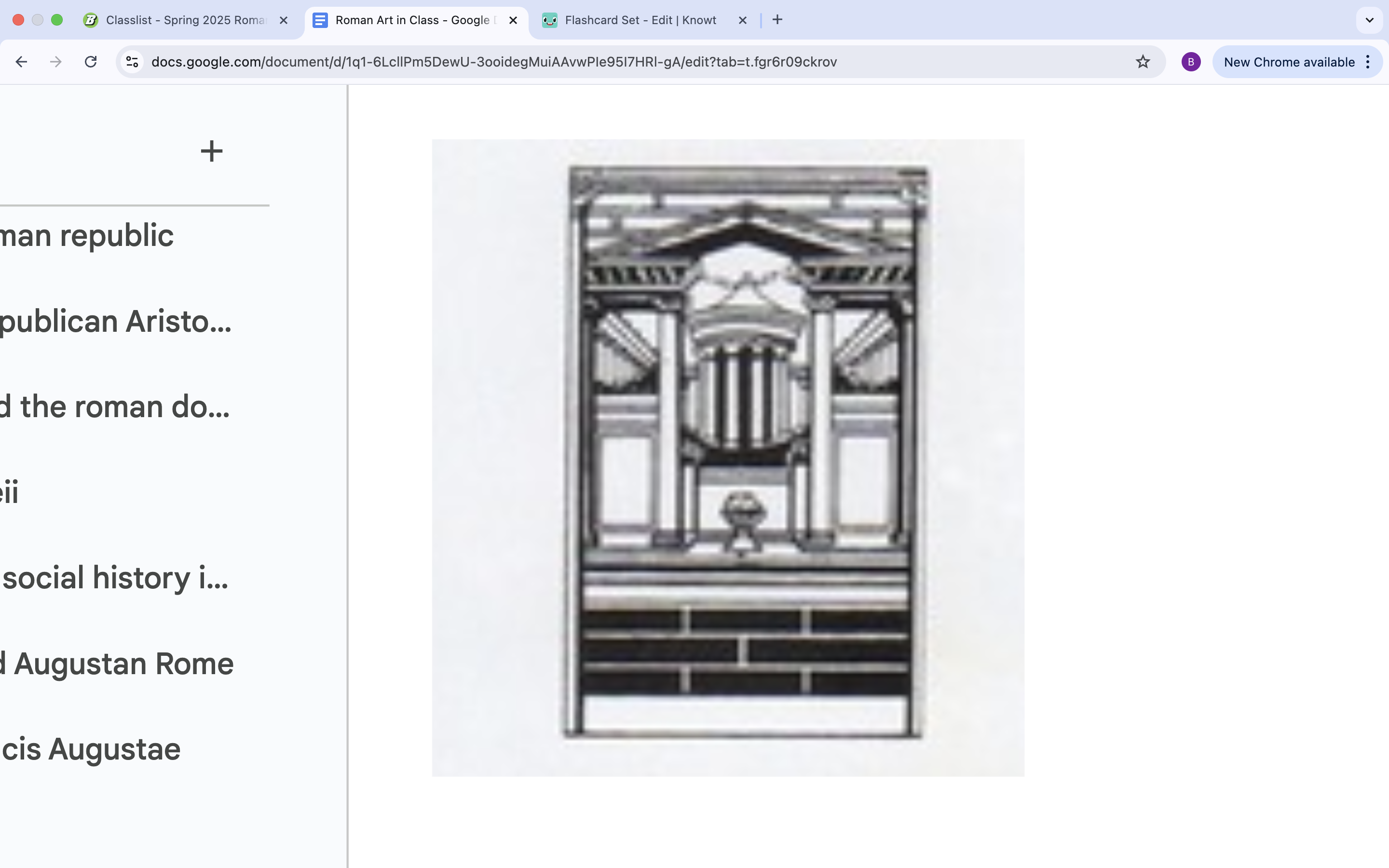
SECOND STYLE:
(early 1st c BC): pictorial imitation of architecture
-Starting to play with depth
-part of it has masonry imitation
-the other part is open to engage in the depth conversation
-more experimentation
-who is driving the conversation (patron or artist)
Rome - Casa dei Grifi
SECOND STYLE:
(early 1st c BC): pictorial imitation of architecture
-how first style ties into second style
-illusionistic architecture
-almost too many patterns
The house of a newly wealthy person who wants to show that
-bring decorative standards at home up to current standards
SECOND STYLE:
(early 1st c BC): pictorial imitation of architecture
The villa of the mysteries
-to host
-name from painted program in the hospitality portion
-shows a figural cycle
-has interchange in composition between first style and second style
Boscoreale (in pompeii)
-40-30 BC
-second style
-wealthy areas
-Villa of Publius Fannius Synistor: cubiculum (50-40 BC)
during the first part of 1st c AD but he never painted over
-painting is all about illusion
Odyssey landscapes via Graziosa, Esquiline, Rome. before 46 BC
Indication of another kind of trend
Utilizes perspective
Imitates the architectural setting
Shows the journeys about Odyssey
Key scenes/stories from times you expected to know
Primaporta 20 BC, Suburban home of Livia. Triclinium
Winter dining room, ⅔ of it is below ground so it's warmer
Room to engage your imagination, you're meant as the viewer to imagine you're inside of a grotto(cave)
Carefully engineered painting, may be seen to fit in with other message making with augustan programs
Abundance of the natural world, but untamed(no gardener), just the guard of natural fertility
Some say its a Comment on augustan restoration of order, triumph of order over chaos, and a comment on nature
The garden room is private, the public does not go there
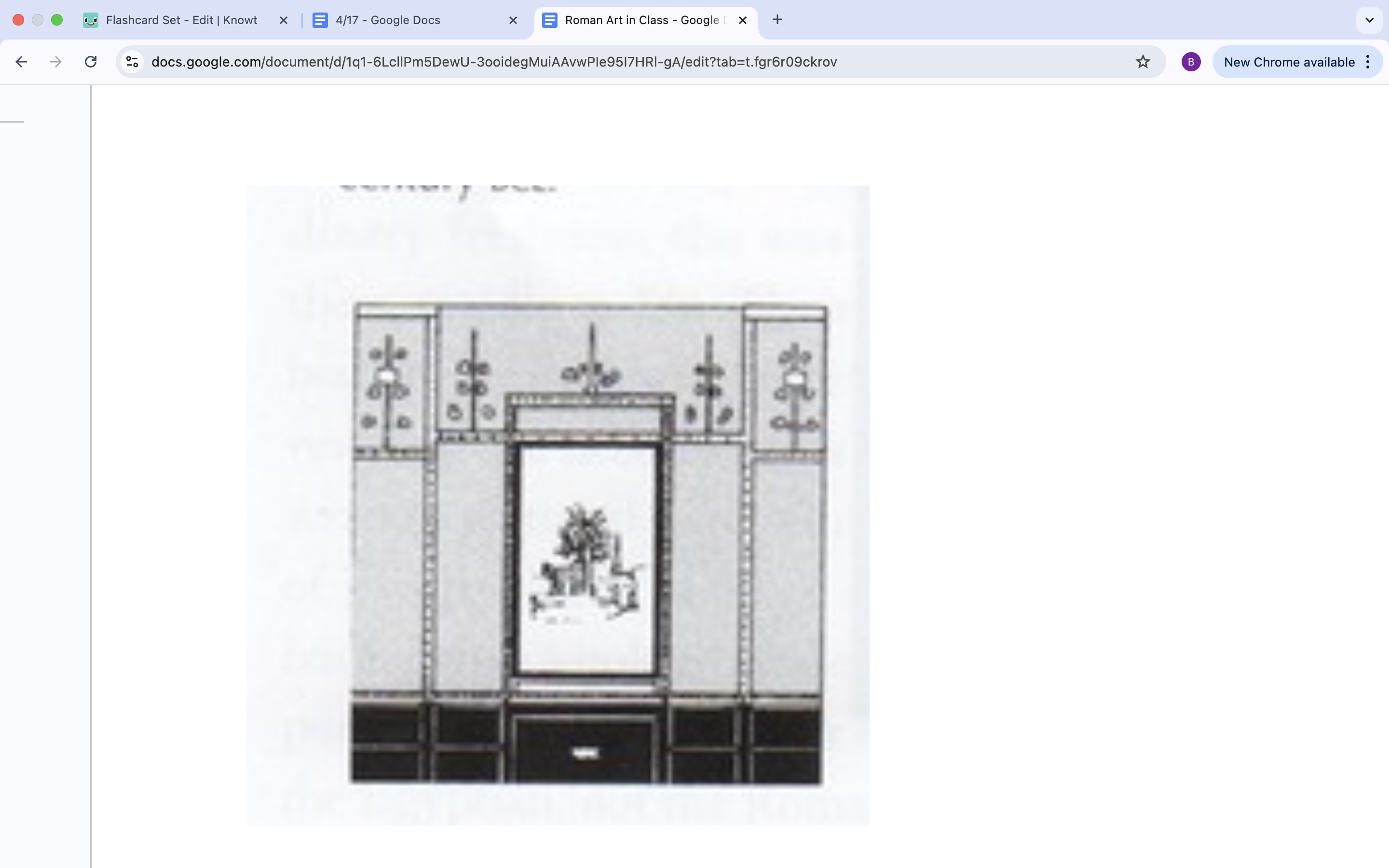
The Third Pompeian Style
-The third style (20 BC - AD 20): rejects illusion, prefers surface ornament
2 phases
Rejects illusionism; turns toward simple and ornate effects
Phase 2 shows rejection of elegance, use of polychromatic compositions
Interest in architectural image
Disinterest in the open wall,, prefers a closed wall, very intricate detail on the closed wall, real interest in miniaturistic effect
More ornate(complex), less cluttered
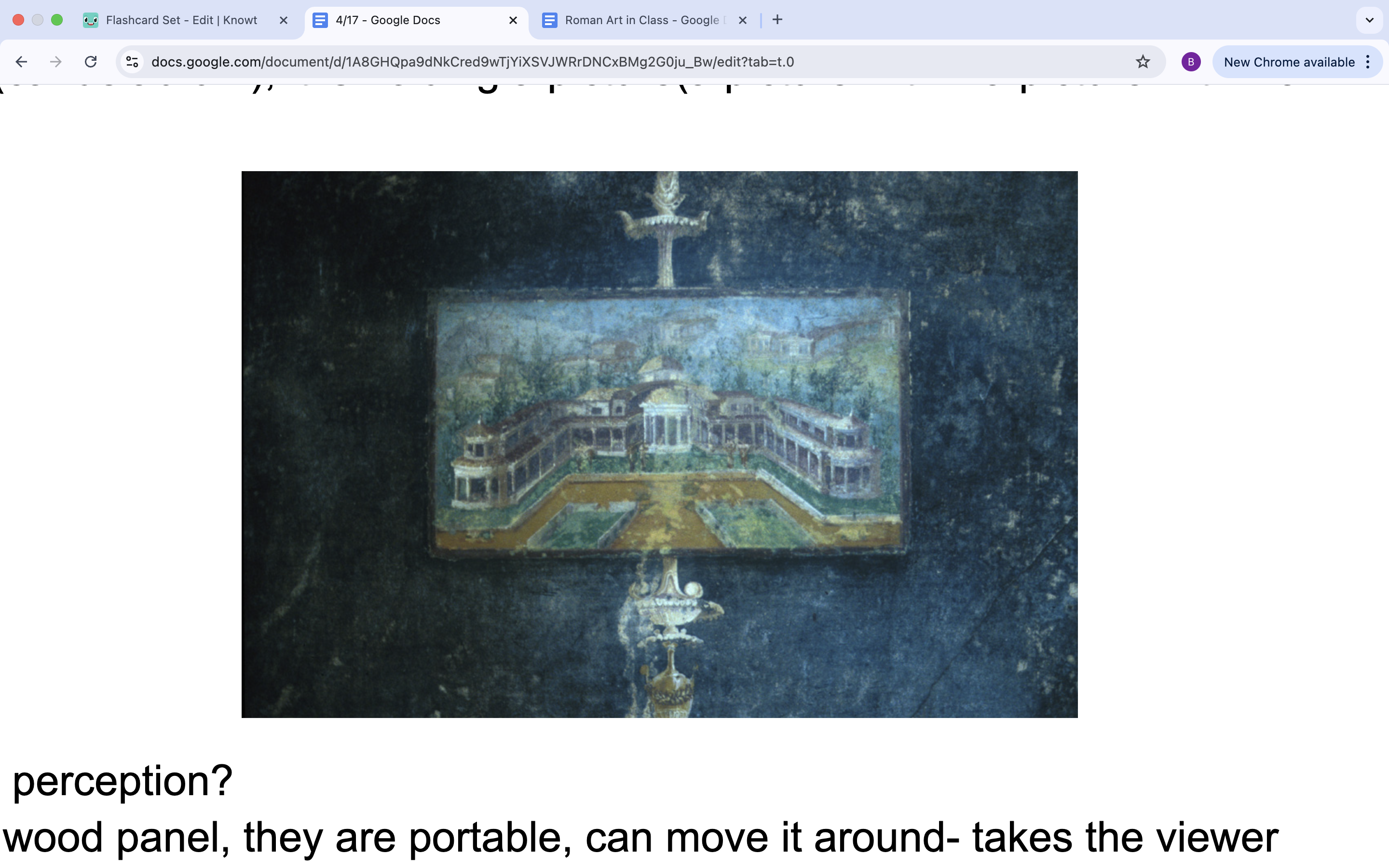
House of M. Lucretius Fronto from Pompeii(40-50 AD)
Very intricate borders
Idea of a focal point panel, that dominates a part of a wall, an obvious point to look
Another approach is new– there is a long metal piece-imitating a portable stand you have in your room(candelabrum), it is holding a picture(a picture within a picture within a picture)- is it depth perception?
Pinax- painting on wood panel, they are portable, can move it around- takes the viewer to somewhere fantastical
Boscotrecase
Mythological room
Interest in primary color contrasts, and this being one of the main aims of the composition?
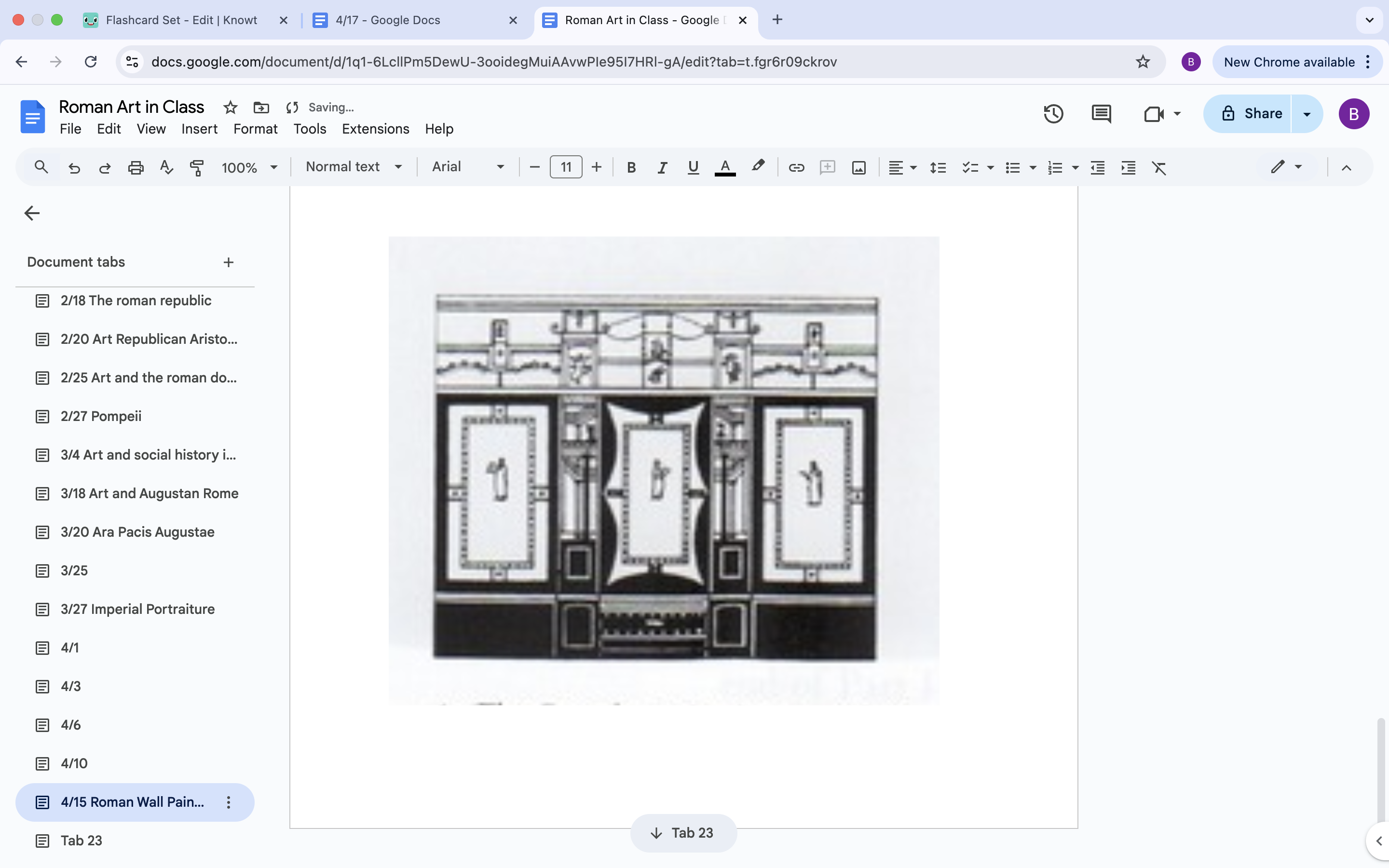
Fourth Pompein style
(following AD 20): eclectic, a little bit of everything
An eclectic style of painting
Baroque- characterized by extravagance, complexity, exaggeration, or flamboyance
A little bit of everything
House of the Vettii
Wealthy people, garment washing business
Pentheus scene
Pentheus is an idiot and manages to stumble into a group of women that go into an ecstatic state and tear things apart, including him
greek mythology is a useful pool to which to sample and you end up with these rooms that are eclectic and ornate..
fourth style
Pompeii- House of the Tragic Poet
Highest quality decorative programs
What about the arrangement of the painting help explain choices that are made, are there themes, there is interactivity that we should presume that comes with these art programs
Atrium
South wall– wedding of zeus and hera, and aphrodite
East wall- achilles and Briseis, and helen and paris
West wall- abduction of amphitrite, and wrath of achilles
The Domus Aurea (64-68 AD)
The trends in pompeii, aren't limited to Pompeii
Follow the 4th style - intricate
Long forgotten